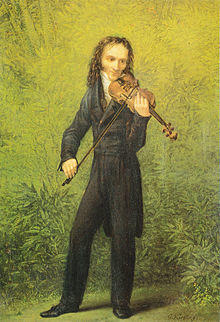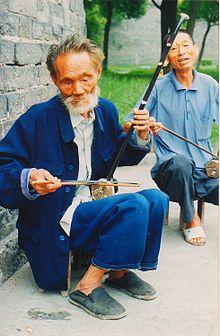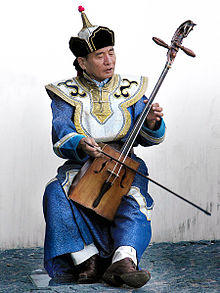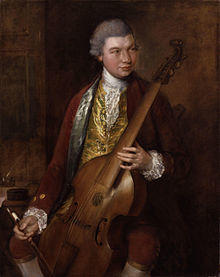Bowed string instruments are a subcategory of string instruments that are played by a bow rubbing the strings. The bow rubbing the string causes vibration which the instrument emits as sound.
The Arabic rabāb is the earliest known bowed instrument,[1] and the ancestor of all European bowed instruments, including the rebec, lyra and violin.[2]
List of bowed string instruments
Violin family

Niccolò Paganini playing the violin, by Georg Friedrich Kersting (1785–1847)
- Pochette
- Violin (violino)
- Viola (altviol, bratsche)
- Cello (violoncello)
- Double bass (contrabasso)
- Variants on the standard members of the violin family include
- Tenor violin
- Five string violin
- Cello da spalla
- Baroque violin
- Kontra
- Kit violin
- Sardino
- Stroh violin
- Låtfiol
- Hardanger fiddle
- Lira da braccio
- Octobass
Viol family (Viola da Gamba family)
- Treble viol (treble viola da gamba)
- Alto viol (alto viola da gamba)
- Tenor viol (tenor viola da gamba)
- Bass viol (bass viola da gamba)
- Variants on the standard four members of the viol family include:
- Pardessus de viol
- Division viol
- Lyra viol
- Baryton
- Violone
- Viola d'amore
- Lirone
- Vihuela de arco
Lyra and rebec type
Chinese bowed instruments

Two performers playing the Erhu, sometimes known as the Chinese fiddle.
Rosined wheel instruments

A performer playing the Morin Khuur, the Mongolian Horse Fiddle
The following instruments are sounded by means of a turning wheel that acts as the bow.
- Organistrum
- Hurdy-gurdy
- Donskoy ryley
- Dulcigurdy a.k.a. Vielle à roue et à manche
- Drejelire
- Lira
- tekerő
- Ninera
- Kaisatsuko
- Violano Virtuoso
- Wheelharp
- Viola organista
- Harmonichord
- Bowed clavier
Other bowed instruments
- Masenqo
- Violoncello da spalla
- Ravanahatha
- Ajaeng
- Yaylı tambur
- Kingri string Instrument
- Shichepshin
- Đàn nhị
- Đàn hồ
- Đàn gáo
- Sohaegeum
- Haegeum
- Kokyū
- sorud
- Chuurqin
- Daxophone
- Arpeggione
- Bowed psaltery
- Bowed dulcimer
- Jouhikko
- Talharpa
- Gue
- Vielle
- Giga
- Fiðla
- Tautirut
- Agiarut
- Crwth
- Neola
- Bowed guitar
- Musical saw
- Morin khuur
- Gusle
- Saw duang
- Saw sam sai
- Saw u
- Salo (instrument)
- Tro Khmer
- Tro sau toch
- Tro sau thom
- Tro u
- huqin
- Sarangi
- Sarangi (Nepali)
- Sarinda
- Esraj
- Nyckelharpa (Swedish keyed fiddle)
- Ghaychak
- Gadulka
- Gudok
- Kobyz
- Sorahi
- Byzaanchy
- Igil
- Imzad
See also
- Bow stroke
References
- ^ "rabab (musical instrument) - Encyclopædia Britannica". Britannica.com. Retrieved 2013-08-17.
- ^ Encyclopædia Britannica (2009), lira, Encyclopædia Britannica Online, retrieved 2009-02-20
